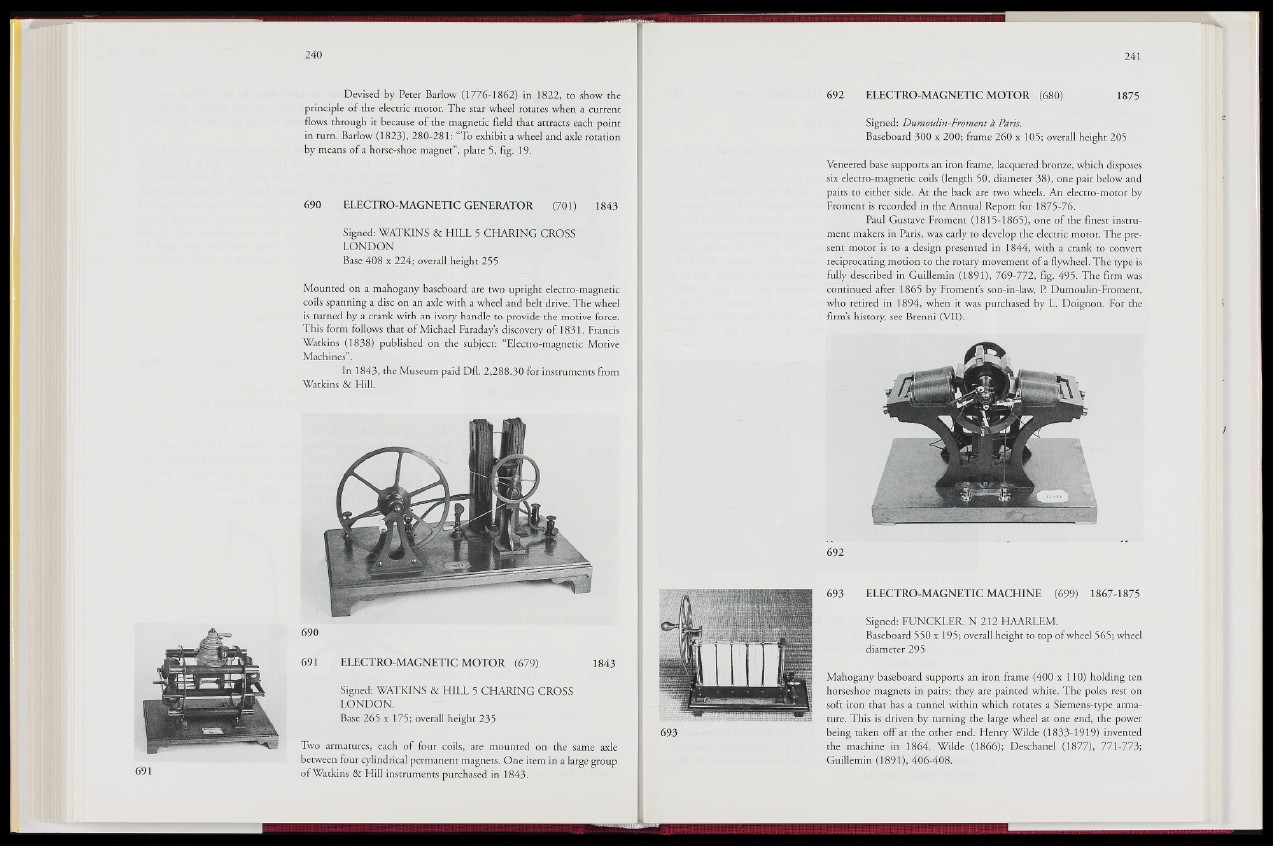
Devised by Peter Barlow (1776-1862) in 1822, to show the
principle of the electric motor. The star wheel rotates when a current
flows through it because of the magnetic field that attracts each point
in turn. Barlow (1823), 280-281: “To exhibit a wheel and axle rotation
by means of a horse-shoe magnet”, plate 5, fig. 19.
690 ELECTRO-MAGNETIC GENERATOR (701) 1843
Signed: WATKINS & HILL 5 CHARING CROSS
LONDON
Base 408 x 224; overall height 255
Mounted on a mahogany baseboard are two upright electro-magnetic
coils spanning a disc on an axle with a wheel and belt drive. The wheel
is turned by a crank with an ivory handle to provide the motive force.
This form follows that of Michael Faraday’s discovery of 183M Francis
Watkins (1838) published on the subject: “Electro-magnetic Motive
Machines”.
In 1843, the Museum paid Dfl. 2,288.30 for instruments from
Watkins & Hill.
690
691 ELECTRO-MAGNETIC MOTOR (679) 1843
Signed: WATKINS & HILL 5 CHARING CROSS,
L O N D o f e ':
Base 265-x 175; overall height 235
Two armatures, each of four coils, are mounted on the same axle
between four cylindrical permanent magnets. One item in a large group
®1 ofWatkins & Hill instruments purchased in 1843. •
692 ELECTRO-MAGNETIC MOTOR (680) 1875
Signed: Dumoulin-Froment à Paris.
Baseboard 300 x 200; frame 260 x 105; overall height 205
Veneered base supports an iron frame, lacquered bronze, which disposes
six electro-magnetic coils (length 50, diameter 38), one pair below and
pairs to either side. At the back are two wheels. An electro-motor by
Froment is recorded in the Annual Report for 1875-76.
Paul Gustave Froment (1815-1865), one of the finest instrument
makers in Paris, was early to develop the electric motor. The present
motor is to a design presented in 1844, with a crank to convert
reciprocating motion to the rotary movement of a flywheel. The type is
fully described in Guillemin (1891), 769-772, fig. 495. The firm was
continued after 1865 by Froment’s son-in-law, P. Dumoulin-Froment,
who retired in 1894, when it was purchased by L. Doignon. For the
firmahistory, see Brenni (VII).
692
693 ELECTRO-MAGNETIC MACHINE (699) 1867-1875
Signed: FUNCKLER. N 212 HAARLEM.
Baseboard 550 x 195; overall height to top of wheel 565; wheel
diameter 295
Mahogany baseboard supports an iron frame (400 x 110) holding ten
horseshoe magnets in pairs; they are painted white. The poles rest on
soft iron that has a tunnel within which rotates a Siemens-type armature.
This is driven by turning the large wheel at one end, the power
being taken off at-the other end*:,: Henry Wilde (1833-1919): invented
the:,machine in 1864. Wilde (1866); Deschanel (1877), 771-773;
Guillemin (1891), 406-408.